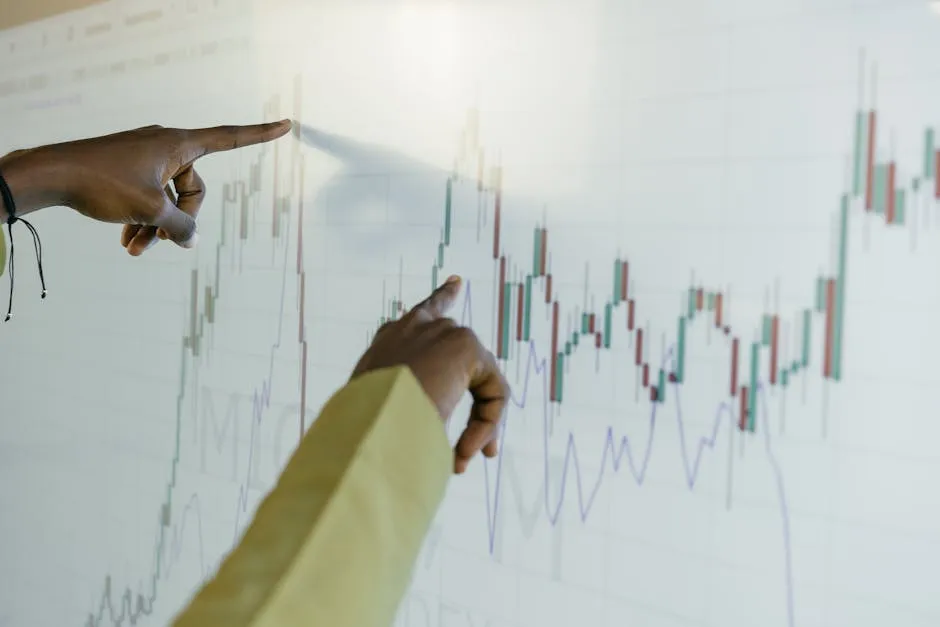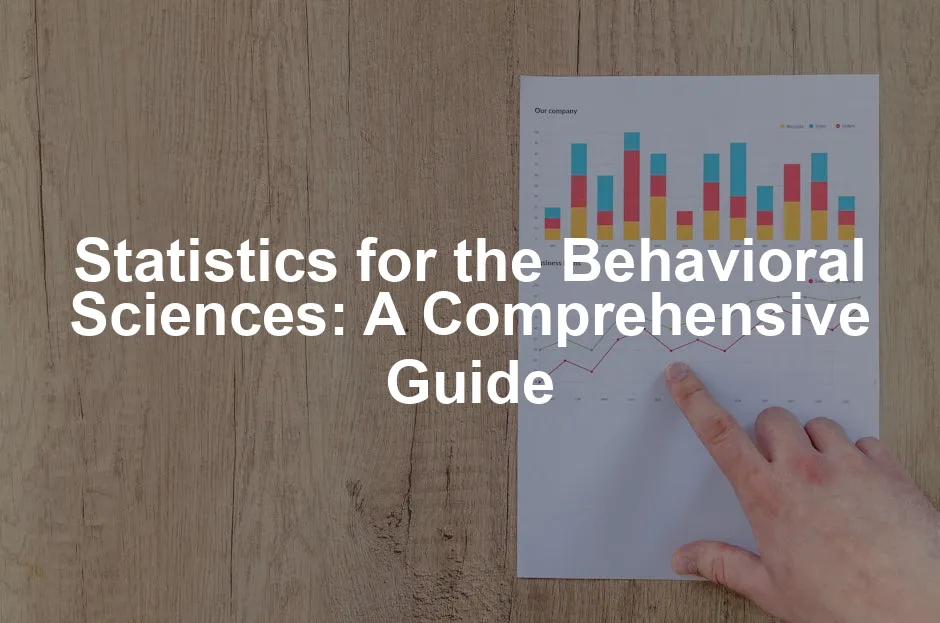Introduction
Statistics is like the secret sauce of behavioral sciences. It’s what transforms raw data into meaningful insights. Imagine trying to understand human behavior without the numbers to back it up! Whether it’s psychology, sociology, or any related field, statistics is key. It helps researchers design studies, analyze results, and ultimately make sense of the world around us.
Why should you care about statistics? Well, think of it this way: statistical literacy is a superpower! It allows you to critically evaluate research, spot trends, and even make informed decisions in your everyday life. From understanding reports in the news to interpreting research findings, statistics is everywhere. If you’re looking to boost your statistical knowledge, consider checking out Statistics for Dummies—a great starting point!
In this article, we’ll cover the fundamentals of statistics in behavioral sciences. We’ll discuss what behavioral sciences entail, the importance of statistical methods, and how these tools shape research and interventions. So, grab your calculator, and let’s dive into the world of numbers!

Understanding Statistics in Behavioral Sciences
What Are Behavioral Sciences?
Behavioral sciences encompass a range of disciplines that study human behavior. This includes psychology, sociology, anthropology, and more. Essentially, these fields aim to understand what makes us tick.
Statistics plays a crucial role here. Researchers rely on statistical methods to collect and analyze data. For instance, in psychology, you might see studies assessing the effectiveness of a new therapy. Researchers will gather data from participants, analyze it, and draw conclusions based on statistical findings. Without statistics, these studies would be like cooking without a recipe—pretty chaotic!
Importance of Statistical Methods
Statistical methods are the backbone of research in behavioral sciences. They guide research design, data analysis, and interpretation. Imagine trying to assess the impact of a new educational program without knowing how to analyze the data collected from students. You’d be lost in a sea of numbers!
Let’s look at some examples. The famous Stanford Prison Experiment is a prime illustration. Researchers utilized statistical analysis to make sense of the behavior changes in participants. Similarly, a study examining the effects of social media on mental health relies on statistics to evaluate trends and draw meaningful conclusions. If you’re looking for a comprehensive guide to statistical analysis, consider the book Discovering Statistics Using SPSS.
In conclusion, understanding statistics is vital for anyone in the behavioral sciences. It allows researchers to design robust studies and interpret data accurately, leading to real-world applications that can change lives. So, whether you’re a budding psychologist or a seasoned sociologist, embracing the power of statistics will enhance your research skills and insights. Get ready to crunch some numbers and unlock the secrets behind human behavior!

Key Statistical Concepts
Statistics is the backbone of the behavioral sciences. It provides the tools to summarize, analyze, and interpret data. Understanding both descriptive and inferential statistics is essential for anyone looking to make sense of research findings.
Descriptive Statistics
Definition and Importance
Descriptive statistics summarize data, providing a snapshot of what the data reveals. They give researchers a way to present large amounts of information in a clear and understandable manner. Think of it as the highlight reel of a sports game—showcasing key plays without diving into every single detail.
Measures of Central Tendency
There are three primary measures of central tendency: mean, median, and mode.
- Mean: This is the average of all data points. It’s calculated by adding up all values and dividing by the number of values. Use the mean when the data is normally distributed, and there are no extreme outliers.
- Median: This is the middle value when data points are arranged in order. If the dataset has an even number of observations, the median is the average of the two middle numbers. The median is your go-to measure when dealing with skewed data or outliers, as it is less affected by extreme values. statistics poland median salary 2024
- Mode: This is the most frequently occurring value in a dataset. The mode is particularly useful for categorical data where we want to know which category is the most popular. For example, in a survey about favorite ice cream flavors, the mode would indicate the flavor that most respondents selected. statsmodels residuals statistics

Measures of Variability
While central tendency tells us about the “center” of the data, measures of variability show how spread out the data points are.
- Range: This is the difference between the highest and lowest values in a dataset. It gives a quick sense of the spread but can be misleading if there are outliers.
- Variance: Variance measures the average of the squared differences from the mean. A high variance indicates that the data points are spread out over a wider range, while a low variance suggests they are clustered closely around the mean.
- Standard Deviation: This is the square root of the variance and provides a measure of variability in the same units as the data. A small standard deviation means that the data points tend to be close to the mean, whereas a large standard deviation indicates that they are spread out over a larger range of values. For instance, test scores in a class can show how consistent students’ performances are.
- If you’re looking to dive deeper into R programming, check out Data Analysis with R Programming—it’s a fantastic resource!

Inferential Statistics
Introduction
Inferential statistics take us a step further. They allow us to make predictions or inferences about a population based on sample data. This is crucial because it’s often impractical or impossible to study an entire population. the problem with inferential statistics
Common Tests
- t-tests: These tests compare the means of two groups to see if they are significantly different from each other. For instance, a t-test might be used to compare test scores between students who study with a tutor versus those who do not.
- ANOVA (Analysis of Variance): This test extends the t-test to compare means among three or more groups. For example, if a researcher wants to compare the effectiveness of three different teaching methods on student performance, ANOVA would be the appropriate choice.
- Chi-Square Tests: These tests assess how likely it is that an observed distribution is due to chance. They are often used for categorical data to determine if there is a significant association between two variables. For example, a chi-square test could analyze whether there’s a relationship between gender and preference for a particular type of music.

Effect Size and Statistical Power
Effect size is a measure of the strength of the relationship between two variables. It provides context to the significance of findings. A statistically significant result with a small effect size may not be practically significant.
Statistical power, on the other hand, refers to the probability that a test will correctly reject a false null hypothesis. Higher power means a greater chance of detecting an effect when there is one. Researchers aim for a power of at least 0.80, indicating an 80% chance of detecting an effect if it exists. If you want to explore statistical power analysis further, I recommend the book Statistical Power Analysis Book.
In summary, understanding these key statistical concepts—descriptive and inferential—is crucial for anyone involved in behavioral sciences. They provide the tools needed to interpret data effectively, making sense of the complex patterns that emerge in research. So, whether you’re analyzing college students’ test scores or evaluating therapy effectiveness, these statistical methods will be your trusty sidekicks!

Statistical Software in Behavioral Sciences
In the realm of behavioral sciences, statistical software is a game-changer. These tools simplify complex data analysis, allowing researchers to focus on what truly matters: understanding human behavior. With the right software, interpreting results becomes a breeze. No more deciphering cryptic formulas or spending hours on calculations—just clear insights and actionable findings! To get started, consider using SPSS Statistics Software.
Statistical software also enhances collaboration among researchers. It provides a common ground for sharing methodologies and results. When everyone uses the same tools, misunderstandings are minimized. Plus, many software packages come with built-in tutorials, making them accessible even for those just starting.

Commonly Used Programs
SPSS
SPSS (Statistical Package for the Social Sciences) reigns supreme in behavioral research. This user-friendly software is perfect for analyzing survey data and conducting various statistical tests. SPSS offers a wide range of features, including data management, statistical analysis, and graphical representation of results. Researchers love its intuitive interface, which allows even novices to navigate with ease. macos ibm spss statistics fix 28.1.1
You can perform everything from descriptive statistics to complex multivariate analyses with just a few clicks. With SPSS, you can quickly generate reports and visuals, making it easier to communicate findings to stakeholders. It’s no wonder SPSS is a staple in academic institutions and research organizations worldwide!

R and Python
R and Python are rapidly gaining traction in the behavioral sciences. These programming languages offer immense flexibility and power for data analysis. R is specifically designed for statistical analysis, boasting numerous packages tailored for different techniques. Whether you’re interested in linear regression or machine learning, R has a solution for you. an introduction to statistical learning with python book length
Python, on the other hand, is a general-purpose programming language that excels in data manipulation and visualization. With libraries like Pandas and Matplotlib, researchers can perform statistical tests and create stunning graphs. The best part? Both R and Python are open-source, meaning they’re free to use! This accessibility encourages researchers to dive into data analysis without breaking the bank.

User-Friendly Options
Not everyone wants to wrestle with programming languages or complex software. Enter JASP and Jamovi—user-friendly alternatives that make statistical analysis accessible to everyone. JASP (Just Another Statistical Program) offers a sleek interface and straightforward functionality. It’s designed for those who want to perform statistical tests without getting bogged down in technical details.
Jamovi takes this a step further by providing a spreadsheet-like experience. Users can easily input data and perform analyses with a few clicks. Both programs are great for students and researchers who seek a no-fuss approach to statistics. They even support R syntax for those looking to transition to more advanced analyses later. If you’re interested in visualizing your data, check out the Data Visualization Toolkit to enhance your presentations.
In summary, the right statistical software can significantly enhance your research experience in the behavioral sciences. Whether you opt for SPSS, embrace the power of R and Python, or choose user-friendly tools like JASP and Jamovi, the options are plentiful. These tools not only simplify the analysis process but also empower researchers to uncover meaningful insights that can impact lives. So, gear up and choose the software that fits your needs—your research will thank you!

Real-World Applications of Statistics in Behavioral Sciences
Statistics plays a pivotal role in behavioral sciences, providing essential insights into human behavior. From research findings to policy decisions, the influence of statistical analysis is profound. Let’s explore how statistics shapes research, impacts policy, and is poised for future trends.
Application in Research
In the realm of behavioral sciences, statistical methods are not just useful—they’re essential. Consider the Stanford Prison Experiment, a classic study demonstrating the power of social situations on behavior. Researchers used statistics to analyze how participants adapted to their roles, leading to groundbreaking insights into authority and conformity. By employing t-tests, they compared behavior across different groups, revealing significant findings about human nature.
Another compelling case is the 2018 study on social media use and mental health. Researchers gathered data from thousands of participants to assess the correlation between time spent on social media and reported feelings of loneliness. Using regression analysis, they found a statistically significant relationship, prompting further inquiries into how online interactions influence mental health. If you want to explore more about this topic, consider reading Naked Statistics for a fun and insightful take on statistical concepts.
Statistics also aids in understanding complex phenomena, such as the impact of trauma on psychological well-being. A 2020 meta-analysis synthesized data from multiple studies, employing ANOVA to compare outcomes among various trauma types. The findings revealed crucial insights into effective therapeutic approaches and informed treatment modalities.
These examples highlight how statistical methods drive meaningful research in behavioral sciences, shaping our understanding of human behavior and guiding future studies.

Impact on Policy and Practice
Statistics doesn’t just reside in academia; it directly influences policy-making in critical areas like healthcare, education, and social services. Policymakers rely on data-driven insights to craft effective interventions. For instance, during the COVID-19 pandemic, statistical models helped predict disease spread, informing public health responses and resource allocation. A great resource for understanding these applications is the book Practical Statistics for Data Scientists.
In education, statistical analyses guide curriculum development and evaluation. A study examining the effectiveness of a new teaching method utilized chi-square tests to analyze student performance data. The results led to the adoption of evidence-based practices, improving educational outcomes.
Moreover, in social services, statistical evaluations of programs help determine their efficacy. For example, a government initiative aimed at reducing homelessness employed statistical methods to assess its impact. By comparing pre- and post-program data using paired t-tests, the analysis showed a significant decrease in homelessness rates, leading to continued funding and expansion of the program.
These examples showcase how statistical analysis is integral in shaping policies that address societal issues. By providing concrete evidence, statistics empowers decision-makers to implement effective solutions that genuinely impact people’s lives.

Future Trends
The future of statistics in behavioral sciences is bright, with emerging trends that promise to enhance research capabilities. One notable trend is the increasing integration of machine learning and artificial intelligence in data analysis. As these technologies evolve, researchers can analyze vast datasets more efficiently, uncovering patterns and insights that were previously difficult to identify.
Another trend is the growing emphasis on open science and transparency in research. Statisticians are advocating for open data practices, allowing researchers to share their datasets and methodologies. This transparency fosters collaboration and reproducibility, strengthening the credibility of findings.
Moreover, user-friendly statistical software is becoming more prevalent. Programs like JASP and Jamovi offer intuitive interfaces, making statistical analysis accessible to a broader audience. This democratization of statistics is crucial for empowering students and researchers who may lack extensive training.
Finally, the rise of big data analytics is reshaping the landscape of behavioral research. With the ability to analyze large datasets from various sources, researchers can explore complex relationships and gain deeper insights into human behavior. This trend promises to revolutionize how we approach behavioral science research.
In conclusion, statistics serves as a cornerstone in behavioral sciences, offering invaluable tools for research, policy-making, and future advancements. By harnessing the power of statistics, we can unlock a deeper understanding of human behavior and make informed decisions that enhance our society. The journey of statistical exploration continues, promising exciting developments and discoveries ahead.

Conclusion
Statistics is not just numbers; it’s the heartbeat of the behavioral sciences. Throughout this article, we’ve uncovered the pivotal role statistics plays in understanding human behavior. We explored how it aids researchers in designing studies, analyzing data, and drawing meaningful conclusions. Without statistics, our understanding of complex human behavior would be akin to searching for a needle in a haystack—frustrating and nearly impossible!
Statistical literacy is essential in today’s research landscape. It empowers professionals to critically evaluate studies, discern trends, and make informed decisions. Whether you’re a budding psychologist or a seasoned sociologist, grasping statistical methods can enhance your research prowess and professional credibility.
Moreover, as behavioral science evolves, so does the necessity for robust statistical knowledge. Trends in data analysis, like the integration of machine learning and AI, are reshaping the field. To stay relevant, researchers must embrace these advancements.
So, what’s the takeaway? Don’t shy away from statistics! Instead, consider it a valuable toolkit for your career. Pursuing further education in statistics can open doors to new opportunities and enhance your research skills. Whether it’s enrolling in a course or picking up a textbook, every bit of knowledge counts. For those looking for a deeper dive, I highly recommend The Elements of Statistical Learning—it’s a game changer!
Embrace the challenge, and you’ll find that statistics can be as exciting as the study of human behavior itself. Dive into the world of numbers, and watch as they transform your understanding of the fascinating field of behavioral sciences!

FAQs
What is the difference between descriptive and inferential statistics?
Descriptive statistics and inferential statistics serve different purposes. Descriptive statistics summarize data from a sample, providing simple summaries about the sample and the measures. For example, if you have a classroom of students and you calculate the average test score, that’s descriptive statistics. It merely describes what’s happening in your sample. In contrast, inferential statistics use a random sample of data taken from a population to make inferences or predictions about that population. For instance, if you conduct a survey of 100 students and use their responses to predict the behavior of all students at your school, you’re using inferential statistics. This type of analysis allows researchers to draw conclusions beyond the immediate data.
How can I improve my statistics skills?
Improving your statistics skills is easier than you might think! Here are some tips to get you started: 1. **Online Courses**: Platforms like Coursera and Khan Academy offer free courses on statistics. 2. **Textbooks**: Dive into textbooks like “Statistics for the Behavioral Sciences” by Gravetter and Wallnau for a comprehensive understanding. 3. **Practice Problems**: Websites like Khan Academy provide practice questions to reinforce your learning. 4. **Join Study Groups**: Collaborating with peers can enhance your understanding and make learning more enjoyable. 5. **Utilize Statistical Software**: Familiarize yourself with software like SPSS or R to apply what you’ve learned in real-world scenarios.
What are some common misconceptions about statistics in behavioral sciences?
Statistics often comes with a lot of myths. Here are a few common misconceptions: 1. **”Statistics is just about numbers.”** Nope! It’s about understanding patterns and making informed decisions based on evidence. 2. **”You need to be a math genius to understand statistics.”** False! A basic understanding is enough to grasp essential concepts. 3. **”Correlation means causation.”** Not necessarily! Just because two variables are related doesn’t mean one causes the other. Always consider other factors!
Why is statistical software important for researchers?
Statistical software is crucial in modern research. Here’s why: 1. **Efficiency**: It saves time by automating complex calculations. No more manual number crunching! 2. **Accuracy**: Reduces the risk of human error, ensuring more reliable results. 3. **Data Visualization**: Most programs offer tools to create graphs and charts, making it easier to present findings. 4. **Complex Analysis**: Software can handle advanced statistical techniques that would be daunting to perform by hand. In short, mastering statistical software enhances research quality and productivity, making it an invaluable resource for behavioral scientists.
Please let us know what you think about our content by leaving a comment down below!
Thank you for reading till here 🙂
All images from Pexels




